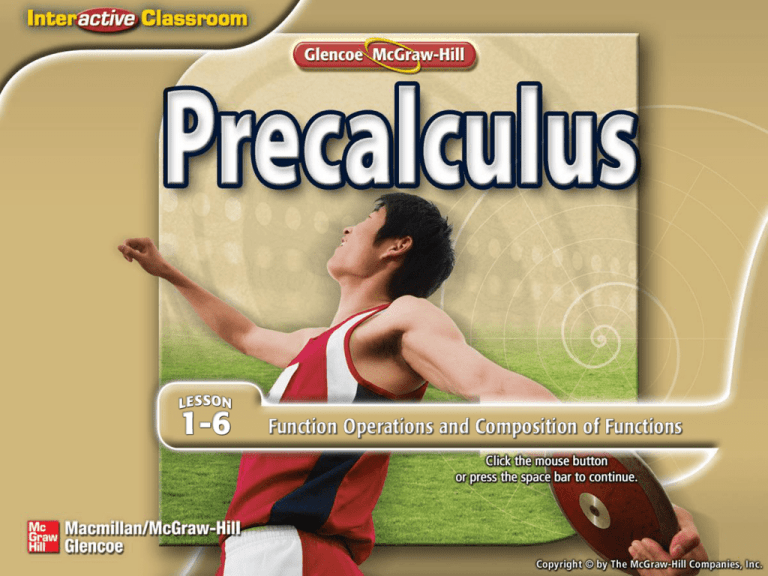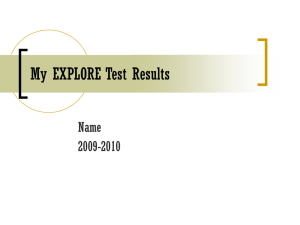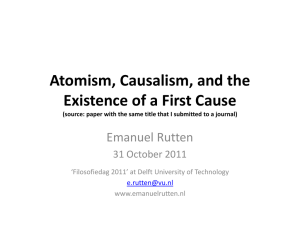ppt
advertisement

Five-Minute Check Then/Now New Vocabulary Key Concept: Operations with Functions Example 1: Operations with Functions Key Concept: Composition of Functions Example 2: Compose Two Functions Example 3: Find a Composite Function with a Restricted Domain Example 4: Decompose a Composite Function Example 5: Real-World Example: Compose Real-World Functions Use the graph of y = x 2 to describe the graph of the related function y = 0.5x 2. A. The parent graph is translated up 0.5 units. B. The parent graph is expanded horizontally by a factor of 0.5. C. The parent graph is compressed vertically. D. The parent graph is translated down 0.5 units. Use the graph of y = x 2 to describe the graph of the related function y = (x – 4)2 – 3. A. The parent graph is translated left 3 units and up 4 units. B. The parent graph is translated right 3 units and down 4 units. C. The parent graph is translated left 4 units and down 3 units. D. The parent graph is translated right 4 units and down 3 units. A. C. B. D. Identify the parent function f(x) if and describe how the graphs of g(x) and f(x) are related. A. f(x) = x; f(x) is translated left 4 units. B. f(x) = |x|; f(x) is translated right 4 units. C. D. You evaluated functions. (Lesson 1-1) • Perform operations with functions. • Find compositions of functions. • composition Operations with Functions A. Given f(x) = x 2 – 2x, g(x) = 3x – 4, and h(x) = –2x 2 + 1, find the function and domain for (f + g)(x). (f + g)(x) = f(x) + g(x) Definition of sum of two functions = (x 2 – 2x) + (3x – 4) f(x) = x 2 – 2x; g(x) = 3x – 4 = x2 + x – 4 Simplify. The domain of f and g are both so the domain of (f + g) is Answer: Operations with Functions B. Given f(x) = x 2 – 2x, g(x) = 3x – 4, and h(x) = –2x 2 + 1, find the function and domain for (f – h)(x). (f – h)(x) = f(x) – h(x) Definition of difference of two functions = (x 2 – 2x) – (–2x 2 + 1) f(x) = x 2 – 2x; h(x) = –2x 2 + 1 = 3x 2 – 2x – 1 The domain of f and h are both of (f – h) is Answer: Simplify. so the domain Operations with Functions C. Given f(x) = x 2 – 2x, g(x) = 3x – 4, and h(x) = –2x 2 + 1, find the function and domain for (f ● g)(x). (f ● g)(x) = f(x) g(x) Definition of product of two functions = (x 2 – 2x)(3x – 4) f(x) = x 2 – 2x; g(x) = 3x – 4 = 3x 3 – 10x 2 + 8x Simplify. The domain of f and g are both of (f ● g) is Answer: so the domain Operations with Functions D. Given f(x) = x 2 – 2x, g(x) = 3x – 4, and h(x) = –2x 2 + 1, find the function and domain for Definition of quotient of two functions f(x) = x 2 – 2x; h(x) = –2x 2 + 1 Operations with Functions The domain of h and f are both, but x = 0 or x = 2 yields a zero in the denominator of domain of Answer: . So, the (–∞, 0) (0, 2) (2, ∞). D = (–∞, 0) (0, 2) (2, ∞) Find (f + g)(x), (f – g)(x), (f ● g)(x), and for f(x) = x 2 + x, g(x) = x – 3. State the domain of each new function. A. B. C. D. Compose Two Functions A. Given f(x) = 2x2 – 1 and g(x) = x + 3, find [f ○ g](x). = f(x + 3) Replace g(x) with x + 3 = 2(x + 3)2 – 1 Substitute x + 3 for x in f(x). = 2(x 2 + 6x + 9) – 1 Expand (x +3)2 = 2x 2 + 12x + 17 Simplify. Answer: [f ○ g](x) = 2x 2 + 12x + 17 Compose Two Functions B. Given f(x) = 2x2 – 1 and g(x) = x + 3, find [g ○ f](x). Answer: = (2x 2 – 1) + 3 Substitute 2x 2 – 1 for x in g(x). = 2x 2 + 2 Simplify [g ○ f](x) = 2x 2 + 2 Compose Two Functions C. Given f(x) = 2x 2 – 1 and g(x) = x + 3, find [f ○ g](2). Evaluate the expression you wrote in part A for x = 2. [f ○ g](2) = 2(2)2 + 12(2) + 17 = 29 Answer: [f ○ g](2) = 29 Substitute 2 for x. Simplify. Find and g(x) = 4 + x 2. A. 2x 2 + 5; 4x 2 – 12x + 13; 23 B. 2x 2 + 11; 4x 2 – 12x + 13; 23 C. 2x 2 + 5; 4x 2 – 12x + 5; 23 D. 2x 2 + 5; 4x 2 – 12x + 13; 13 for f(x) = 2x – 3 Find a Composite Function with a Restricted Domain A. Find . Find a Composite Function with a Restricted Domain To find , you must first be able to find g(x) = (x – 1) 2, which can be done for all real numbers. Then you must be able to evaluate for each of these g(x)-values, which can only be done when g(x) > 1. Excluding from the domain those values for which 0 < (x – 1) 2 <1, namely when 0 < x < 1, the domain of f ○ g is (–∞, 0] [2, ∞). Now find [f ○ g](x). Find a Composite Function with a Restricted Domain Replace g(x) with (x – 1)2. Substitute (x – 1)2 for x in f(x). Simplify. Notice that is not defined for 0 < x < 2. Because the implied domain is the same as the domain determined by considering the domains of f and g, we can write the composition as for (–∞, 0] [2, ∞). Find a Composite Function with a Restricted Domain Answer: for (–∞, 0] [2, ∞). Find a Composite Function with a Restricted Domain B. Find f ○ g. Find a Composite Function with a Restricted Domain To find f ○ g, you must first be able to find , which can be done for all real numbers x such that x2 1. Then you must be able to evaluate for each of these g(x)-values, which can only be done when g(x) 0. Excluding from the domain those values for which 0 x 2 < 1, namely when –1 < x < 1, the domain of f ○ g is (–∞, –1) (1, ∞). Now find [f ○ g](x). Find a Composite Function with a Restricted Domain Find a Composite Function with a Restricted Domain Answer: Find a Composite Function with a Restricted Domain Check Use a graphing calculator to check this result. Enter the function as . The graph appears to have asymptotes at x = –1 and x = 1. Use the TRACE feature to help determine that the domain of the composite function does not include any values in the interval [–1, 1]. Find a Composite Function with a Restricted Domain Find f ○ g. A. D = (–∞, –1) (–1, 1) (1, ∞); B. D = [–1, 1]; C. D = (–∞, –1) (–1, 1) (1, ∞); D. D = (0, 1); Decompose a Composite Function A. Find two functions f and g such that when . Neither function may be the identity function f(x) = x. Decompose a Composite Function Sample answer: Decompose a Composite Function B. Find two functions f and g such that when h(x) = 3x 2 – 12x + 12. Neither function may be the identity function f(x) = x. h(x) = 3x2 – 12x + 12 Notice that h is factorable. = 3(x2 – 4x + 4) or 3(x – 2) 2 Factor. One way to write h(x) as a composition is to let f(x) = 3x2 and g(x) = x – 2. Decompose a Composite Function Sample answer: g(x) = x – 2 and f(x) = 3x 2 A. B. C. D. Compose Real-World Functions A. COMPUTER ANIMATION An animator starts with an image of a circle with a radius of 25 pixels. The animator then increases the radius by 10 pixels per second. Find functions to model the data. The length r of the radius increases at a rate of 10 pixels per second, so R(t) = 25 + 10t, where t is the time in seconds and t 0. The area of the circle is times the square of the radius. So, the area of the circle is A(R) = R 2. So, the functions are R(t) = 25 + 10t and A(R) = R 2. Answer: R(t) = 25 + 10t; A(R) = R 2 Compose Real-World Functions B. COMPUTER ANIMATION An animator starts with an image of a circle with a radius of 25 pixels. The animator then increases the radius by 10 pixels per second. Find A ○ R. What does the function represent? A ○ R = A[R(t)] Definition of A ○ R =A(25 + 10t) Replace R(t) with 25 + 10t. = (25 + 10t)2 Substitute (25 + 10t) for R in A(R). = 100t 2 + 500t + 625 Simplify. Compose Real-World Functions So, A ○ R = 100t 2 + 500t + 625. The composite function models the area of the circle as a function of time. Answer: A ○ R = 100t 2 + 500t + 625 ; the function models the area of the circle as a function of time. Compose Real-World Functions C. COMPUTER ANIMATION An animator starts with an image of a circle with a radius of 25 pixels. The animator then increases the radius by 10 pixels per second. How long does it take for the circle to quadruple its original size? The initial area of the circle is ● 25 2 = 625 pixels. The circle will be four times its original size when [A ◦ R ](t) = 100t 2 + 500t + 625 = 4(625) = 2500. Solve for t to find that t = 2.5 or –7.5 seconds. Because a negative t-value is not part of the domain of R(t), it is also not part of the domain of the composite function. The area will quadruple after 2.5 seconds. Answer: 2.5 seconds BUSINESS A satellite television company offers a 20% discount on the installation of any satellite television system. The company also advertises $50 in coupons for the cost of equipment. Find [c ◦ d](x) and [d ◦ c](x). Which composition of the coupon and discount results in the lower price? Explain. A. [c ◦ d](x) = 0.80x – 40; [d ◦ c](x) = 0.80x – 50; Sample answer: [d ◦ c](x) represents the cost of installation using the coupon and then the discount results in the lower cost. B. [c ◦ d](x) = 0.80x – 40; [d ◦ c](x) = 0.80x – 50; Sample answer: [c ◦ d](x) represents the cost of installation using the discount and then the coupon results in the lower cost. C. [c ◦ d](x) = 0.80x – 50; [d ◦ c](x) = 0.80x – 40; Sample answer: [c ◦ d](x) represents the cost of installation using the discount and then the coupon results in the lower cost. D. [c ◦ d](x) = 0.80x – 50; [d ◦ c](x) = 0.80x – 40; Sample answer: [c ◦ d](x) represents the cost of installation using the coupon and then the discount results in the lower cost.




